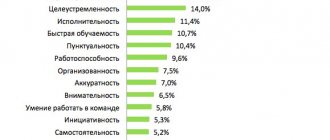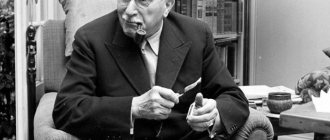Each person has a certain type of nervous system, behavioral characteristics, personality and a set of individual qualities. Knowing this, you can write a psychological portrait of a person or correct deviations. It helps to find reflection inner world person, captures all the feelings and actions of that moment. Each person is an individual, has his own mental world, and can independently regulate and analyze his behavior.
What is a psychological personality characteristic
Psychological characteristics are a set of components of the personality structure that determine the individual’s orientation, character traits and style of activity. Psychological characteristics are based on stable human properties: type of nervous system, temperament, nationality, abilities, qualities of mind.
The psychological characteristics of a person undergo some changes in the process of ontogenetic development, family upbringing and systematic education. Individual elements of psychological characteristics are formed only as a result of the development of character and the development of stable interests of the individual. Family education and schooling are being replaced by self-development and self-education of a person. Starting from adolescence, people consciously form their psychological portrait.
The main components of psychological characteristics are: resilience, unity and activity. On their basis, a person’s value orientations, worldview, style of activity and communication are formed. The dynamic properties of a person allow him to master social roles, achieve his goals, and maintain his socio-psychological status.
The characteristics of a person’s abilities determine his individuality.
How to compose?
How to create a psycho-portrait of me or someone else?
It is advisable to contact specialists , but it is also realistic to cope with the task on your own. The object of study can be one’s own person or another person about whom it is necessary to obtain comprehensive information.
Popular questionnaires will help you correctly leave a psychological portrait :
- J. Rotter test;
- questionnaire L.N. Sobchik;
- R. Cattell's test;
- Leonhard characterological questionnaire.
In addition to questionnaires, other personality assessment methods are also used.
So, you can create a psychological portrait from a drawing, analyze handwriting, conduct a test for non-verbal communication, solve logical riddles, etc.
The simplest research option is to analyze the properties of an object. In this case, it is enough to give a step-by-step description of the ten key personality traits listed above on a piece of paper.
In this case, the objectivity of the assessment is of great importance. It is not always possible for a person to evaluate himself or someone around him as impartially as possible.
Building your psychological portrait will help you understand your own personality, decide on the appropriate type of professional activity, and objectively evaluate the people around you.
Psychological structure of personality
In psychology, the personality structure includes its main characteristics:
- Biological features. These include: the type of nervous system and its properties, the relationship between the processes of excitation and inhibition in it, and the performance of the brain.
- Individual typological qualities. This block is determined by the characteristics of family upbringing and the type of parent-child relationships.
- Character traits that appear in the process of socialization of an individual. The determining factors for the formation of this element of the personal structure are the child’s socio-psychological status in the group of peers, the level of development of his communication skills, and stress resistance.
- Human life experience. It is often understood as an individual’s adaptive abilities, flexibility, ability to analyze one’s actions, and make independent decisions.
Rules for conducting psychological and pedagogical examination
There are fairly clear rules for drawing up a student’s characteristics. One of the fundamental requirements for conducting psychological and pedagogical characterization is objectivity . It is equally important to carefully analyze the factors influencing a child’s development as a whole, taking into account the characteristics of the student. The child should be treated as delicately as possible, minimizing any coercion or pressure on him. Only in this case can a psychological and pedagogical characterization of a student or student be as objective and useful as possible.
The student's characteristics are written by the class teacher and signed by the school director. When writing a psychological profile of a child, you may need the help of a school psychologist, testing and diagnostic results.
Basic psychological characteristics of personality
A general idea of a communication partner is made up of the basic psychological characteristics of his personality.
Interests and inclinations
Among all the psychological characteristics, when drawing up a personality portrait, experts first of all highlight the interests and inclinations of the individual. It is under the influence of a person’s interests that his attitude to reality is formed. The inclinations of the individual form the basis of the orientation and worldview of the individual, which explain certain behavioral reactions.
Interest, being a source of curiosity, directs our attention to certain things. Tendencies push a person towards certain types of activities. In an effort to learn something new, a person is driven by interest. When he begins voluntary practical activity, which is based on creativity, his actions are determined by his inclinations.
There are different approaches to classifying interests:
- An individual's interest can be passive or active. With passive interest, a person needs a mentor who will guide and correct his actions: recommend popular scientific literature, suggest ways to perform activities. With active interest, a person independently engages in one activity or another, reads relevant literature, and tries different work techniques. In the process of active interest, an individual’s individual style of activity is formed.
- According to their orientation, interests are classified into spiritual, social, political, and economic.
- Based on the number of people showing interest, interests can be divided into individual, public and group.
The origin of a person’s interests and inclinations is based on his needs.
If a person strives to satisfy only physiological needs, life seems uninteresting and monotonous to him. Deep interest in a certain type of activity and stable inclinations fill a person’s life with meaning and stimulate his self-development.
A person may have broad interests and be inclined towards different types of activities - in this case they speak of broad erudition and multidirectional development. Also, a person may have a pronounced interest in a particular area of activity - in this case they speak of a deep, sustainable interest of the individual. If, at the same time, a person’s interests and inclinations are subordinate to his life goal and do not interfere with conscientious work, their presence is regarded as a positive socio-psychological characteristic.
An example of the above can be a hobby. If doing what you love does not interfere with work and does not crowd out communication with friends from a person’s life, then it undoubtedly characterizes the individual in a positive way.
You can meet people whose interests and hobbies change quickly. Such people are keen, but not passionate. They are attracted to something new, bright, unusual. For example, they may enroll in a historical fencing class, but quit training after receiving the first injury. Their inclinations are due to natural impressionability. Having tried themselves in a new type of activity, they lose interest in it. Such qualities as inconstancy and impulsiveness will certainly find a place in their psychological portrait. It is very difficult for them to achieve success in any type of activity.
Abilities and giftedness
Ability is a person's biological predisposition to science, sports, or the arts.
Abilities as a psychological characteristic of a person determine the success of a person in performing certain actions. An example of an ability that influences a person’s psychological characteristics is observation. As a rule, teachers, writers, and drivers have this property.
In almost every type of professional activity, to successfully perform their job duties, a person needs the following abilities:
- visual memory;
- spatial thinking and imagination;
- concentration of attention.
When compiling a psychological profile, experts rely on the following types of abilities:
- Intellectual abilities. They provide rapid perception of information, its processing, storage in memory for a long time, as well as the ability of a person to apply existing theoretical knowledge in practice.
- Mathematical abilities. They explain man's inclination towards exact sciences. High development of mathematical abilities is often associated with good logical thinking. These mental properties are essential for accountants, programmers, physicists, mathematicians and economists.
- Technical ability. This group of abilities is needed by people involved in the design and development of innovative mechanisms.
- Creative skills. This type of ability is based on the inherent human imagination and ability to express fantasy.
- Communication skills. With their help, a person easily finds a common language with representatives of any social groups, shows empathy, and wins over them. Journalists, psychologists, politicians, and teachers use communication skills in their professional activities.
- Physical abilities. This group of abilities provides a person with sporting success.
- Literary ability. They explain the writing talent and poetic skills of people.
- Musical abilities. These include a sense of rhythm, a harmonic and melodic ear, and the ability to independently compose original melodies.
Abilities develop in the process of a person mastering practical activities. The basis for the development of abilities is inclinations. If nature has awarded a person with many inclinations, then they speak of talent, which allows him to be successful in various fields of science and art.
A synonymous concept for giftedness is talent, which determines a person’s ability to solve problems in a non-standard way. Talent is not a biological characteristic of a person. It grows out of a person’s interest in a certain activity and manifests itself in the process of performing this activity.
However, without specially organized systematic training, a naturally gifted person will not be able to become successful. In the learning process, the totality of natural inclinations determines the strength of knowledge acquisition and the rapid formation of skills and abilities.
It is impossible to equate a person’s talent and mastery in a particular activity, since giftedness represents a high level of development of natural inclinations, and mastery is the result of conscious work, which is based on the totality of theoretical knowledge, individual skills and abilities of a person.
The pace of development of abilities depends on the presence of giftedness, but learning is decisive in this process. If a person becomes a master of his craft, this means that a new level of development of abilities opens up for him.
It is important to understand that the lack of natural inclinations on the path to mastery in a particular type of activity can be successfully compensated for by such psychological characteristics of a person as: determination, perseverance, hard work, responsibility. These personality traits create the prerequisites for mastering almost any type of activity, provided there is a strong interest in it.
Thus, success in a particular activity can be explained by a variety of human abilities. The lack of some abilities is compensated by the high development of others. This means that the path to a dream is open to everyone. If a person is prepared for difficulties in the process of climbing a mountain, success will certainly await him at the end of the journey.
Every person has abilities. There is no point in comparing your own achievements with the achievements of other people. For the development of society, different talents are needed, which cannot belong to one person. When choosing a life path and profession, you should listen to yourself. After all, work that fully meets the interests and inclinations of an individual brings her not only material rewards, but also pleasure.
Temperament
Temperament is an innate psychological characteristic of a person. Classic patterns of temperament are:
- Sanguine. This is a cheerful person whose feelings quickly replace one another, as they are superficial. The main features of his psychological characteristics are: optimism, carelessness, initiative, multidirectional interests. He is fussy, his movements are fast and precise. The nervous system of a sanguine person is too mobile.
- Choleric. The main psychological characteristics of such a person are: explosive temper, hot temper, excitability, aggressiveness. He reacts vividly to events. His movements and speech are sharp, impetuous, and the pace of work is high. Choleric people lack a balance between the processes of excitation and inhibition in the nervous system.
- Phlegmatic person. This is a slow person who does not tend to demonstrate his experiences. His movements are smooth, his gait is measured. The main features of his psychological characteristics are calmness, prudence, and balance. The nervous system of a phlegmatic person is inactive.
- Melancholic. Such a person is distinguished by impressionability, vulnerability and touchiness. A melancholic person keeps his experiences to himself. Very often, melancholic people demonstrate high development of creative abilities.
“Pure” examples of temperament are rare in everyday life. Most often, the dominant type of temperament is complemented by some traits of another. For example: a phlegmatic person with a melancholic dominant, a choleric person with a sanguine dominant. The psychological characteristics of a person in this case will depend on the situation and circumstances.
So, temperament is a set of psychological characteristics of a person that determines a person’s general mobility, the speed at which his feelings arise and their severity, and the peculiarities of the manifestation of his emotional experiences. Each person needs to learn to subjugate his temperament - then the positive traits of his personality will come to the fore.
Character
Character is the psychological core of personality, which is formed from early childhood to adolescence. The structure of this psychological characteristic includes cognitive processes, emotionality, willpower, individual style of activity, and value orientations. Character traits determine a person’s attitude towards work. They are manifested in the motives of his activities, in the methods that he chooses to solve the assigned problems.
The psychological characteristics of a person are based on the following character traits:
- General character traits. They form the psychological type of the individual. These include: consistency, activity, integrity, honesty, discipline, courage.
- Character traits that reflect an individual’s self-attitude and self-perception. These are: modesty, self-esteem, shyness, touchiness, selfishness and egocentrism.
- Character traits that reflect an individual's attitude towards other people. This group includes: sociability, sensitivity, openness, politeness, willingness to help.
- Character traits that reflect an individual's attitude towards work. Among them: hard work, perseverance, initiative, accuracy, conscientiousness, responsibility.
Characterological features form the basis of a person’s worldview.
Knowing the characteristics of a person’s character allows us to predict his reactions. Systematic work on oneself allows a person to form his character, develop positive qualities in himself and eliminate negative ones.
Why bother understanding other people at all?
Quite a logical question, isn't it? We live in peace, try to understand ourselves, and then study others too! Nevertheless, we assure you: this skill will be useful to you, and here’s the point...
Society is the social shell into which we find ourselves immediately after the body. Communications form the basis of any society, because it is no coincidence that the words “society” and “communication” have the same root. But communication is also a skill that must be learned to achieve effective interactions that benefit everyone involved. Profiling just helps to learn as much as possible about a person, to recognize the benefits and threats, advantages and risks brought as a result of this interaction. And drawing up a socio-psychological portrait is the first stage of personality analysis.
There is a point of view according to which it is impossible to create a socio-psychological portrait of a person based only on a short interaction. Ildar Zinurov, a writer and coach, a practicing psychologist of our time, adheres to precisely this position and argues that videos of the famous person being studied, riding in the elevator every morning with a neighbor or lectures with a teacher at a university cannot serve as a full-fledged basis for drawing up psychological portraits of these people [ AND. Zinurov, 2019]. And of course, profiling is not a miracle technique that helps you read a person in a couple of minutes.
In fact, this is a whole science and, perhaps, even a feature of an individual person. It is known that a person is born with such a quality as empathy (the ability to understand and grasp the state of another person, his emotions and mood), and this is one of the fundamental qualities of any profiler. By the way, profiling is often used in the field of criminology when investigating crimes, when compiling psychological portraits of criminals.
Here are examples of the most famous profilers from the history of criminology:
- Robert Ressler. Or, as he is also called, Sherlock Holmes of the 20th century. Ressler was an FBI agent, at the same time he lectured on criminology and wrote several books on the psychology of crime. In his works one can see many descriptions of portraits of murderers, rapists and other criminals. Ressler's character served as the inspiration for Jack Crawford's character in The Silence of the Lambs.
- Paul Ekman. Professor at the University of California at San Francisco, one of the most famous American psychologists, Paul Ekman is an expert in the field of detecting lies, as well as classifying human emotions. It is this area of scientific research and interests that, of course, does not leave aside such organizations as the FBI, CIA, large corporations, including the animation studios Pixar and Industrial Light and Magic. You may have even watched the popular TV series Lie to Me, for which a scientist served as a consultant.
- Joe Navarro. Cuban-American author who also spent time as an FBI agent. Navarro has written several books on nonverbal communication, mainly focusing on what lies behind a speaker's words. As a public speaker, Navarro advises people, teaches them to notice what is not usually said, and “read” others by their body language.
As you can see, knowledge from the field of profiling helps not only to acquire useful skills related to communications, but also to achieve career success. Often, corporations invite profilers to interviews in order to select a suitable candidate for a vacancy, and government security agencies even hunt professional profilers in order to investigate crimes more effectively. Therefore, you may need the ability to draw up a socio-psychological portrait of a personality as one of the key areas of profiling in a variety of situations [Zh. Rizabekova, 2020].
You can take a closer look at the biographies and scientific works of the above authors yourself, and we will share with you what a socio-psychological portrait of a personality consists of.
Methodology for compiling psychological characteristics
Psychological characteristics of a person are compiled by psychologists using the following methods:
- Observation. Through specially organized observation, the psychologist receives information about the characteristics of an individual’s behavior. In psychological characteristics, observation results indirectly reflect personality characteristics.
- Psychodiagnostic methods. Using personality tests and questionnaires, the psychologist determines the client’s temperament type, his interests and inclinations, and the prevailing motives for his activity. This information is the main one in the psychological characteristics.
- Sociometry. With the help of this diagnostic tool, the psychologist receives information about the socio-psychological status of the individual in the educational or work community. Sociometry allows us to identify the characteristics of a person’s interpersonal interaction with friends and colleagues.
- Interview. If sufficient information about a person cannot be obtained through tests, the psychologist develops a series of questions that he asks the client. This method of collecting information is used to clarify facts and eliminate contradictions.
Psychological characteristics begin with the listing of a person’s personal data: indicating the last name, first name and patronymic, date of birth, place of residence, reporting information about family members and characteristics of family upbringing. The following are described:
- inclinations and interests;
- personality abilities;
- characteristics of temperament and character;
- a person's attitude towards himself;
- a person's attitude towards other people;
- a person's attitude towards work.
An example of a person's psychological characteristics
Letovaltsev Andrey Yurievich
Date 04/19/2008.
Mother: Letovaltseva Anna Gennadievna.
Father: Letovaltsev Yuri Alekseevich.
Place of residence: Novodvinsk
The child is raised in a complete family. Parents take an active part in the boy's life. For Andrey, his older brother is a role model.
The boy shows interest in exact sciences and has a high level of development of logical thinking. For two years, Andrey has been attending robotics courses and participating in city and regional competitions.
The boy's level of voluntary attention is above average. There are no signs of fatigue when performing work. The pace of work is high.
The boy has a high level of visual memory development. Auditory memory is moderately developed. The dominant channel for obtaining information is visual.
The predominant motive for activity is to avoid failure. The level of anxiety corresponds to the age norm.
In the course of solving intellectual problems, Andrey demonstrates independence and rationality. Willingly comes to the aid of his comrades. Shows interest in pair work. When working in a group, he imposes his opinion on his comrades and makes many comments. He takes criticism addressed to him painfully.
In a group of peers, the boy strives to become a leader. He is ambitious and active. Andrey tries to assert himself at the expense of other children. However, in order to become a leader, the boy lacks sensitivity and attentiveness to others. In addition, the boy has high self-esteem.
Andrey has a choleric type of temperament. The young man is emotional, assertive, and purposeful. He often has conflicts in his relationships with peers. Poor development of communication skills does not allow making concessions and finding a compromise solution to controversial situations. The boy is characterized by sudden mood changes.
There are outbreaks of aggression in behavior. It is difficult for a boy to control his emotional reactions.
Based on the results of psychological diagnostics, Andrey can be recommended a course of individual sessions with a psychologist aimed at correcting the emotional-volitional sphere. The boy will also benefit from group classes in the form of training to develop communication skills.
Portrait No. 2: Narcissistic
Such a tyrant will not beat anyone. A narcissistic despot simply does not need this - he is above this everyday life. This man is simply obsessed with himself. He is usually attractive and intelligent.
He sincerely believes that his interests are simply beyond the reach of simple estimates, i.e. wife and children. These men build their relationships in the family in such a way that those around them begin to truly obey them. A narcissistic tyrant builds a wall around himself; outsiders are strictly prohibited from entering his world. This person will not stoop to primitive scandals, he will simply show his contempt and begin to behave detached and independent.
Narcissistic tyrants love to get sick. They constantly listen to themselves and their health. Such a man can talk for hours about his illnesses, but they are very annoyed when someone in the household suddenly gets really sick. This causes him discomfort and irritation. No one in his family should get sick, especially his wife.
Such family tyrants are useless in everyday life. They don't stoop to doing housework. They prefer not to pay attention to burnt out light bulbs or leaking faucets.
Such men treat their children coolly. Their children are usually very quiet and obedient. The wife must raise their offspring so that they do not bother dad and do not distract him from narcissism.
In sex, such a tyrant cares only about his own pleasure. He doesn't care about his wife's feelings. He tries only for himself, his beloved.
About a friend
In my essay I will tell you a little about a wonderful person, my close friend, whose name is Alexandra. I want to write right away that I have known Sasha for a very long time and during this time she has become a proven and reliable support for me.
The first time I saw Sasha, I couldn’t help but notice her appearance. She is a rather tall girl with graceful hands. She has surprisingly thin and long fingers, on which she always wears a calm, but at the same time stylish manicure. In addition to the grace of her hands, she has a wasp waist and long legs. They say about such people that they need to go into the modeling business, but Alexandra herself, despite her well-groomed appearance, is a rebel and restless. She does not like to spend a lot of time in front of the mirror; it is better to go to dance training or go to the pool at this time.
Returning to her appearance, I would like to note her amazing eyes. They are gray-blue in color, very deep and thoughtful. Sasha's hair is blond and slightly curled. If you see Sasha in the morning, you will notice funny curls at the ends of her hair. My friend has a few freckles on her face, but they don’t spoil her at all; rather, on the contrary, they are a highlight and make her look light and summery.
Sasha's hair is medium length and brown in color. She loves to wear them in a high bun or a loose, fluffy braid. Sasha prefers a sporty style of clothing, but a couple of times a week she can be seen in a feminine dress or a fashionable skirt. My friend is very attractive and beautiful.
In addition to her interesting appearance, Alexandra has a rich inner world. She is well-read and devotes a lot of time to studying. She is also a reliable and loyal friend who will always help and support in difficult life situations. I feel good and happy that we spend time together. We can talk on the phone for hours, walk in the rain and have sleepovers together. I trust Sasha and know that any secret can be revealed to her.
My friend also loves her family very much and tries to help her mother with housework and looking after her younger brother. She is a good person and I am glad that I have her.









